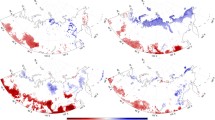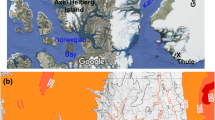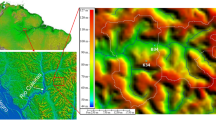Summary
This paper summarises some of the key results from two European field programmes, WINTEX and LAPP, undertaken in the Boreal/Arctic regions in 1996–98. Both programmes have illustrated the very important role that snow plays within these areas, not only in the determination of energy, water and carbon fluxes in the winter, but also in controlling the length of the summer active season, and hence the overall carbon budget. These studies make a considerable advance in our knowledge of the fluxes from snow-covered landscape and the interactions between snow and vegetation. Also some of the first measurements of greenhouse gas fluxes (carbon dioxide and methane) are reported for the European arctic and sub-arctic. The measurements show a considerable variability across the arctic, with very high instantaneous values from sub-arctic birch and fen areas and extremely low fluxes reported from the polar desert in the high arctic. The overall annual budgets are everywhere limited by the very short active season in these regions. The heat flux over a high latitude boreal forest during late winter was found to be high. At low solar angles the forest shades most of the snow surface, therefore an important part of the radiation never reaches the snow surface but is absorbed by the forest. This indicates that in areas with sparse vegetation and low solar angles, absorption of direct solar radiation is due to an apparent vegetation cover, which is much greater than the actual one.
The first steps are taken in using these measurements to improve models, both point soil/vegetation/atmosphere transfer schemes and 3D meteorogical models. The results are encouraging; increasing the realism progressively improves the representation of the fluxes. A start is made in developing landscape, or catchment scale models. There seems to be some hope that comparatively simple relationships between evaporation and photosynthesis and leaf area may be sufficiently robust to allow the use of remotely sensed images to investigate the areally averaged exchanges.
It is suspected that high latitude regions will experience considerable climatic and environmental change in the coming decades. A well found prediction of how these regions will respond requires a comprehensive knowledge of how vegetation will respond and how the changed vegetation will interact with the snow cover and the atmosphere. The studies from the LAPP and WINTEX programmes presented in this volume are an important contribution to this understanding and provide a useful foundation for future research.
Similar content being viewed by others
Author information
Authors and Affiliations
Additional information
Received March 6, 2001
Rights and permissions
About this article
Cite this article
Harding, R., Gryning, SE., Halldin, S. et al. Progress in understanding of land surface/atmosphere exchanges at high latitudes. Theor Appl Climatol 70, 5–18 (2001). https://doi.org/10.1007/s007040170002
Issue Date:
DOI: https://doi.org/10.1007/s007040170002




